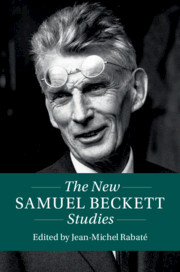Book contents
- The New Samuel Beckett Studies
- Twenty-First-Century Critical Revisions
- The New Samuel Beckett Studies
- Copyright page
- Contents
- Figures
- Contributors
- Editor’s Introduction
- I The Expanded Canon
- II New Contexts and Intertexts
- III New Hermeneutic Codes
- Chapter 9 Beckett’s Queer Art of Failure
- Chapter 10 “Que voulez-vous?”
- Chapter 11 Beckett’s Disabled Language
- Chapter 12 Beckett and Mathematics
- Chapter 13 Beckett’s Bilingual Explorations
- Chapter 14 Waiting for Godot among the Prisoners
- Index
Chapter 11 - Beckett’s Disabled Language
from III - New Hermeneutic Codes
Published online by Cambridge University Press: 17 June 2019
- The New Samuel Beckett Studies
- Twenty-First-Century Critical Revisions
- The New Samuel Beckett Studies
- Copyright page
- Contents
- Figures
- Contributors
- Editor’s Introduction
- I The Expanded Canon
- II New Contexts and Intertexts
- III New Hermeneutic Codes
- Chapter 9 Beckett’s Queer Art of Failure
- Chapter 10 “Que voulez-vous?”
- Chapter 11 Beckett’s Disabled Language
- Chapter 12 Beckett and Mathematics
- Chapter 13 Beckett’s Bilingual Explorations
- Chapter 14 Waiting for Godot among the Prisoners
- Index
Summary
My wound existed before me,” wrote poet Joë Bousquet: “I was born to embody it.”Bousquet was injured by a bullet in 1918 and he lived with paraplegia and the pain it caused him until 1950, composing poems infused with opiated imagery. Samuel Beckett never had a similarly life-changing wound, though he experienced considerable ill health and a serious injury. Still, there remains an uncanny sense that he too found in the crevices of physical and mental suffering, and then in the frailties that came at the end of his long life, flashes of linguistic possibility for which his writing had always been searching. In late life, Beckett struck up a friendship with writer Lawrence Shainberg, who was exploring neurological dysfunction in his work.
- Type
- Chapter
- Information
- The New Samuel Beckett Studies , pp. 195 - 214Publisher: Cambridge University PressPrint publication year: 2019
- 2
- Cited by



